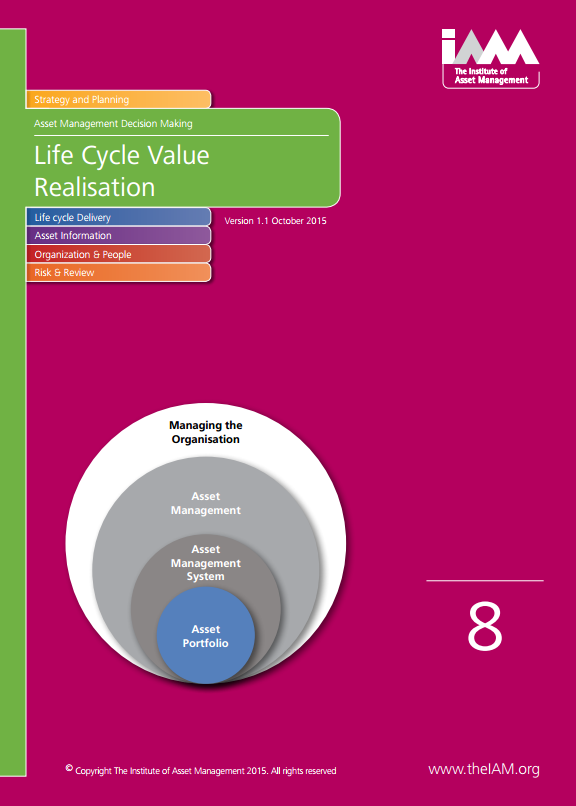01 Oct 2015
Subject 8: Life Cycle Value Realisation
Version 1.1 October 2015
This SSG describes what people should consider and understand when making decisions that impact the costs and value associated with their assets. It is to be read in conjunction with the good practice approaches to asset management as detailed in PAS 55 and ISO 55000.
The Life Cycle Value Realisation SSG is relevant to organisations:
- that are asset intensive, where significant expenditure, resources, performance dependency and/or risks are associated with the creation/acquisition, utilisation, maintenance or renewal/disposal of assets
- with a significant portfolio of assets, or where the performance of an asset system and the management of assets are central to the effective delivery of service, product or other business objectives
- where there is a business or public accountability requirement to demonstrate best value in the safe management of assets and provision of associated services
With thanks to our sponsors of this publication.
| CONTENTS | |
|---|---|
| Acknowledgements | 2 |
| 1 INTRODUCTION TO SUBJECT SPECIFIC GUIDELINES 1.1 Purpose of the SSGs 1.2 The SSGs In Context 1.3 SSGs And The Issue Of Complexity Versus Maturity 1.4 Further Reading |
4 |
| 2 SCOPE OF THIS SSG 2.1 Target Sectors 2.2 How To Use This SSG |
6 |
| 3 WHAT IS LIFE CYCLE VALUE REALISATION? 3.1 At The Portfolio Level 3.2 At The System Level 3.3 At The Asset Level 3.4 The Benefits Of Life Cycle Value Realisation 3.5 Financial & Business Performance Benefits 3.6 Consistency, Robustness & Auditability Of Decisions 3.7 Engagement And Credibility With Stakeholders 3.8 Rationalising Corporate Data |
8 |
| 4 CONCEPTS, PRINCIPLES AND KEY FACTORS 4.1 Asset Life And Life Cycle Activities 4.2 Life Cycle Costs 4.3 Value, Risk, Sustainability And Intangibles 4.4 Evaluation Of Risk 4.5 Evaluation Of Sustainability 4.6 Evaluation Of Intangibles |
10 10 11 11 11 12 12 |
| 5 GOOD PRACTICE GUIDE FOR LIFE CYCLE VALUE REALISATION 5.1 Implementation Framework 5.2 Good Practice - inputs 5.3 Good Practice - Ideas & Options 5.3.1 Good Practice - Asset Data 5.3.2 Good Practice - Asset Information 5.3.3 Good Practice - Risk Data Constraints 5.3.3.1 Strategic Business Requirements 5.3.3.2 Business/Regulatory Environment 5.3.3.3 Decision Making Criteria & Methodology 5.3.4 Good Practice - Constraints 5.3.5 Good Practice - Analysis 5.3.5.1 LCC & Value Estimation/Modelling 5.3.5.2 Decision Support Analysis Modelling 5.3.5.3 Refine/Optimise 5.3.6 Good Practice - Decision Support Outputs 5.3.6.1 Options 5.3.7 Good Practice - Stakeholder Consultation 5.3.8 Organisational Factors to be considered 5.3.9 Good Practice - Review/Update/Audit |
14 14 14 14 15 15 15 16 16 16 16 16 16 17 17 18 18 18 18 19 |
| 6 CASE STUDIES 6.1 Severn Trent Water - Capital Maintenance Planning 6.2 Sasol - Optimal Renewal Timing For ‘Obsolete’ Assets 6.3 Sellafield Limited 6.4 National Grid - Whole Life Value Assessment Of A Sustainable Heat Recovery Project 6.5 Network Rail - Whole Life Cost Modelling For A Strategic Business Plan 6.6 London Underground - System Optimisation Of Line Upgrades 6.7 Electricity North West - Maximising Value For Money From Asset Intervention Programme 6.8 London Underground - Optimal Painting Regime To Extend Asset Life 6.9 National Grid - Modernising The UK Electricity Transmission Network 6.10 Citipower - The Network Operator Wanted To Justify Their Investment/Maintenance Strategy To Stakeholders |
20 |
| 7 BIBLIOGRAPHY |
32 |

















